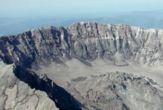Mountain Building Quicker than Thought

Mountains appear so ancient and timeless that it can be difficult to comprehend their slow rise from flat obscurity. Geologists have long modeled the process as slow, grinding and hot.
A new discovery suggests the buildup can be much quicker and cooler than thought, however.
"One way that mountains form is when two parts of the Earth's crust collide and fold over each other under pressure," says Bas Hensen of the University of New South Wales. "This process simultaneously liberates long-buried rocks and consumes others for millions of years."
Hensen and his colleagues studied the geology of the Southern Caledonides in western Norway. A continental collision occurred there some 425 million years ago, causing certain rocks to be buried to depths of 36 miles (60 kilometers). These rocks have since returned to the surface, where glaciers have ground and polished them.
The researchers found that the time between burial and resurfacing -- called the orogenic cycle -- took 13 million years, instead of some 40 million years as previously thought. The implication is that the mountains themselves grow up faster than expected.
Besides shorter time scales, the rock recycling process inside mountains may happen at unexpectedly cool temperatures.
"Until now, scientists believed that most of the 'rock package' gets heated to around 700 degrees centigrade [1,300 Fahrenheit]," Hensen said. "Precise dating based on radiogenic isotope data confirms that most of the rocks are heated only to around 400 degrees centigrade [750 Fahrenheit]."
Get the world’s most fascinating discoveries delivered straight to your inbox.
Radiogenic isotope dating involves the comparison of two forms of a certain element -- in this case argon. The ratio of argon-40 and argon-39 acts like a clock -- ticking off the time since the rock was cool enough to trap argon. Carbon dating works on a similar principle to date fossils.
The argon ratios found in the Norwegian rocks indicate they were heated over very short periods -- in some cases as short as 10 years. To explain these surprising results, the researchers have devised a new "cold crust" model, which erects mountains rather briskly.
"It neatly explains many previously puzzling geological observations and may be relevant to other mountain-building events around the world," said James Lee of Queen's University in Canada.
The study was detailed in the June 30 edition of the journal Nature.



